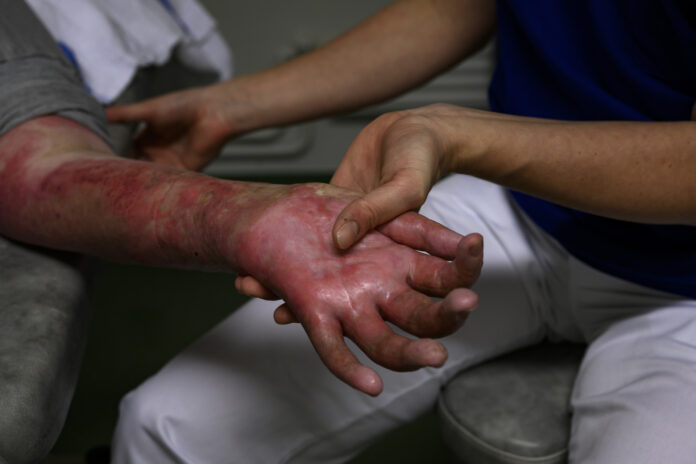Burn units, also known as burn centres, are specialized medical facilities dedicated to the treatment and rehabilitation of patients who have sustained severe burn injuries. These units are equipped with advanced medical technology and staffed by multidisciplinary teams trained to manage the complex care required for burn victims.
The history of burn units dates back to the early 20th century, with significant advancements made during and after World War II when the need for specialized burn care became increasingly apparent due to wartime injuries. Globally, the development of burn units has transformed burn care, reducing mortality rates and improving the quality of life for survivors. These specialized centres incorporate a variety of medical disciplines, including plastic surgery, dermatology, physical therapy, and psychiatry, to provide holistic care. The emphasis is not only on immediate medical treatment but also on long-term rehabilitation, including physical and occupational therapy, pain management, and psychological support.
In Pakistan, the evolution of burn care has been more gradual. The country’s first dedicated burn unit was established in the 1980s, and since then, efforts have been made to expand and improve burn care services. However, despite these efforts, many burn centres in Pakistan still face significant challenges, including inadequate funding, lack of resources, and insufficient training for medical personnel. The limited number of specialized burn units means that many patients, particularly those in rural areas, lack access to the care they need.
Burn injuries are a significant public health concern in Pakistan, often resulting in severe physical and psychological trauma. Specialized burn centres are essential for providing comprehensive care to these patients, yet many existing facilities face significant challenges. A recent visit to a burn centre revealed a disturbing lack of resources and inadequate care. All the centres struggled to provide basic necessities due to insufficient funding. The absence of essential services, such as intensive care and physiotherapy, further compromised patient outcomes. The lack of resources in many burn centres is not limited to this facility. Across the country, burn units are often underfunded and understaffed. This results in insufficient medical supplies, outdated equipment, and inadequate facilities. The shortage of trained medical personnel, including burn surgeons, nurses, and therapists, exacerbates the problem, leading to delays in treatment and suboptimal care.
The incident at Ahmadpur Sharqia in 2017 highlighted the region’s vulnerability to mass burn injuries and the subsequent strain on overwhelmed medical facilities. A tanker explosion resulted in over 200 deaths and numerous severe burn injuries, overwhelming local hospitals and exposing the inadequacies in emergency preparedness and response. The lack of preparedness for such emergencies is a grave concern. The absence of a coordinated emergency response plan and the limited capacity of existing burn units to handle mass casualties underscore the need for comprehensive disaster management strategies.
To address these critical issues, increased government funding, public-private partnerships, and community engagement are essential. Investing in burn centres, training medical personnel, and raising awareness about burn prevention can significantly improve patient outcomes and save lives. Allocate dedicated funds for burn centres to improve infrastructure, equipment, and staffing. Adequate funding is crucial to ensure that burn centres can provide the necessary medical supplies, maintain modern equipment, and offer competitive salaries to attract and retain skilled healthcare professionals.
This financial support should come from both government and private sectors, with a focus on sustainable long-term investment. Ensure burn centres have access to specialized medical professionals, including surgeons, nurses, physiotherapists, and psychologists. A multidisciplinary approach to burn care is essential for addressing the complex needs of burn patients. Collaboration among various specialists can enhance treatment outcomes and facilitate comprehensive rehabilitation programs.
By prioritizing burn care and investing in specialized facilities, Pakistan can make significant progress in improving the lives of burn survivors and preventing future tragedies. The implementation of these recommendations requires a collaborative effort from government agencies, healthcare providers, non-governmental organizations, and the community. Together, these stakeholders can create a robust burn care infrastructure that meets the needs of all burn patients and ensures their long-term recovery and reintegration into society.
Develop comprehensive emergency plans to effectively manage mass burn casualties. This includes establishing protocols for rapid response, ensuring the availability of necessary medical supplies, and conducting regular training exercises for healthcare personnel. Creating regional burn centers with the capacity to handle large-scale emergencies can improve overall preparedness and reduce the burden on individual facilities.
Implement widespread burn prevention campaigns to educate the public about safety measures and first aid. Raising awareness about common causes of burn injuries, such as household accidents and industrial incidents, can help prevent burns. Public education campaigns should also focus on teaching basic first aid techniques to improve initial responses to burn injuries. Encourage community involvement through volunteer programmes, donations, and partnerships with organizations like APWA (All Pakistan Women’s Association). Community support can play a vital role in enhancing burn care services. Volunteer programmes can provide additional manpower, while donations can help fund necessary resources. Partnerships with local organizations can facilitate outreach and education efforts.
By prioritizing burn care and investing in specialized facilities, Pakistan can make significant progress in improving the lives of burn survivors and preventing future tragedies. The implementation of these recommendations requires a collaborative effort from government agencies, healthcare providers, non-governmental organizations, and the community. Together, these stakeholders can create a robust burn care infrastructure that meets the needs of all burn patients and ensures their long-term recovery and reintegration into society.























